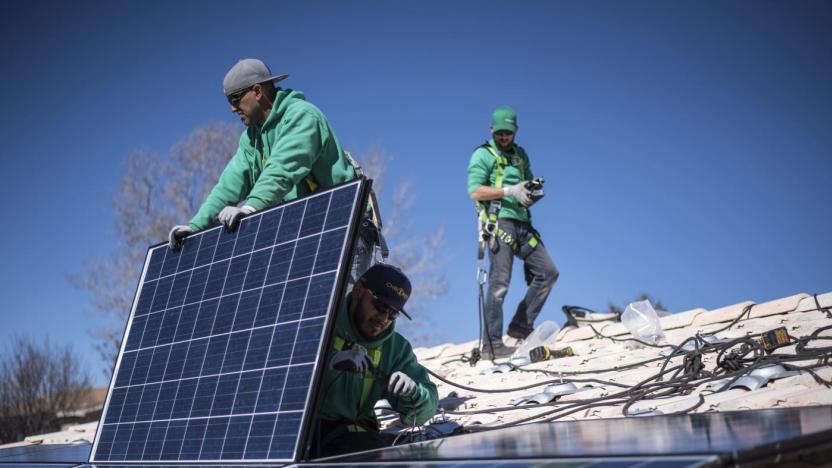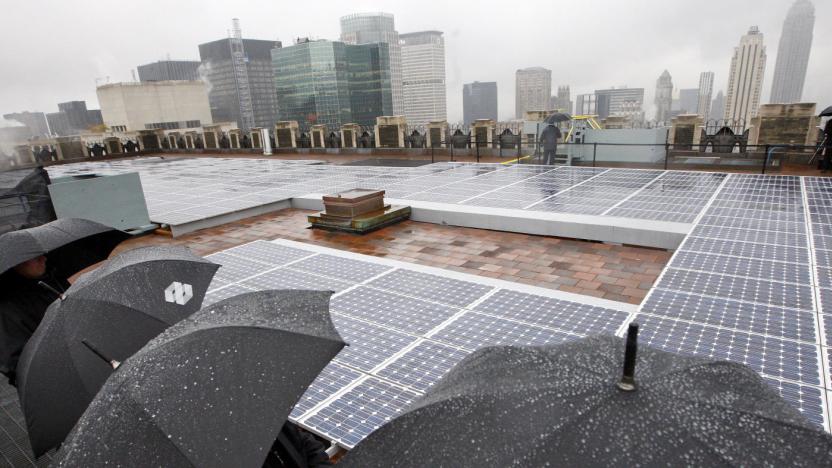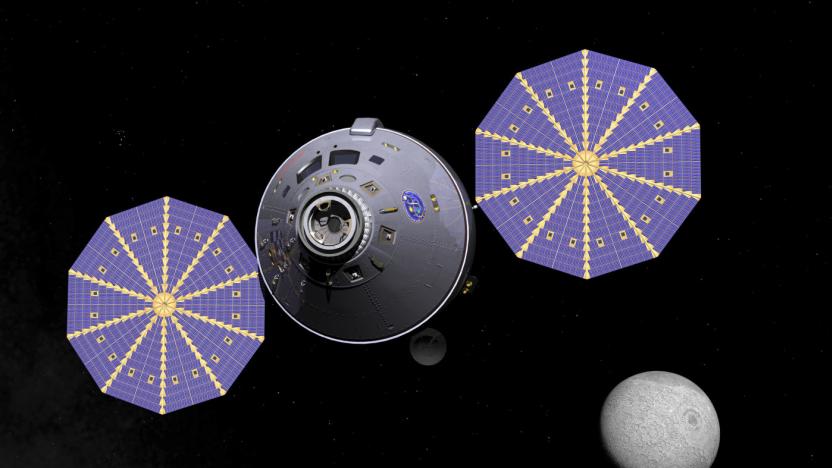solarpower
Latest

Solar-powered aircraft completes its flight across the US
Solar Impulse 2 continues its slow creep around the globe, this time completing its journey across the US by landing in New York City. It first arrived in the continental US back in April when the solar-powered aircraft touched down in San Francisco, and now has completed its 14th leg since leaving Abu Dhabi in March of last year. It's not the fastest way to get around -- especially given delays due to battery damage -- but it is very green, which is the whole point. Next up is an Atlantic Ocean crossing, with a destination in either southern Europe or Northern Africa. Check below for video of the latest flight.

Apple creates a new company to sell solar energy
Apple has a new product quite unlike the ones you're used to: solar energy. The tech giant has formed a new subsidiary called Apple Energy LLC in order to sell surplus solar power generated by its farms in Cupertino and Nevada. As The Verge notes, the company's newest environmental responsibility report says it only generates enough energy to provide 93 percent of the electricity it needs worldwide. However, Apple might have plans to expand its farms even further to prepare for new projects, such as charging stations for the long-rumored Apple car.

Santiago subway will be the first powered mostly by the sun
A subterranean transit system may seem like an unlikely place to find some solar power, but that is exactly how the city of Santiago, Chile hopes to power the trains on its 108-stop, 64-mile Metro system. According to Fast Company, the Santiago Metro will soon be the first in the world to get the majority of its power from renewable resources.

World's largest solar power plant experiences minor meltdown
A small fire temporarily shut down the generator at the Ivanpah Solar Electric Generating System near the California-Nevada border Thursday. According to the Associated Press, some wires at the power plant melted and caught fire after a misaligned mirror zapped them with concentrated sunbeams.

There's a new world record for solar cell efficiency
In a major leap for photovoltaics, scientists at the University of New South Wales in Australia announced that they've developed a solar cell array that's 34.5 percent efficient at converting unfocused sunlight into electricity. That's a 44 percent improvement over the last record holder, which only reached 24 percent efficiency with a larger solar array. The key here is that the scientists were testing normal sunlight without any complex concentrators. The same UNWS team, led by Dr. Mark Keevers and Professor Martin Green, also broke the record for concentrated solar power in 2014, reaching over 40 percent efficiency.

The Energy Department just started its own podcast
You normally don't think of government agencies embracing podcasts -- even if tight budgets aren't a problem, creativity isn't usually their top priority. The US Department of Energy wants to buck that trend, though. It just started up a podcast, Direct Current, that delves into energy technology, government initiatives and energy history. The first episode touches on the problems surrounding the "soft costs" of solar power, solar technology's milestones and the history of the Energy Department itself.

Solar Impulse 2 completes its flight across the Pacific
After months of delays and days of flying, Solar Impulse 2 has finished crossing the Pacific. The sunlight-powered aircraft arrived in San Francisco Bay on the night of April 23rd, with an expected touchdown at Moffett Field (as of this writing) around 3AM Eastern on the 24th. This isn't the toughest stint to date (that honor goes to the 5,061-mile trip from Japan to Hawaii), but it was no mean feat. Pilot Bertrand Piccard had to travel 2,717 miles between Hawaii and San Francisco, with only short naps allowed during the 3-day expedition.

San Francisco mandates rooftop solar panels starting in 2017
San Francisco has been pushing toward 100 percent of its energy to come from renewable resources for a while now. And to further that, the city recently passed legislation that would require new construction to install solar panels on building roofs -- an extension of existing legislation that stated 15 percent of a rooftop be reserved for solar use. The city says this is the first mandate of its kind, and that new buildings 10-stories tall or shorter will have to install photovoltaic panels or solar water heaters. The law won't go into effect until January 1st next year.

Solar cell generates power from raindrops
Rain is normally a solar energy cell's worst nightmare, but a team of Chinese scientists could make it a tremendous ally. They've developed a solar cell with an atom-thick graphene layer that harvests energy from raindrops, making it useful even on the gloomiest days. Water actually sticks to the graphene, creating a sort of natural capacitor -- the sharp difference in energy between the graphene's electrons and the water's ions produces electricity.

NASA picks solar power candidates for deep space missions
NASA is going to need solar power if it wants to keep its future deep space missions running, and that means getting someone to build that light-gathering technology. Fortunately, the agency has some partners lined up. It just picked four solar power technology proposals that could find their way into spacecraft traveling as far as Mars. The outfits negotiating deals are definitely ones you'll know -- ATK, Boeing, Johns Hopkins University and NASA's own Jet Propulsion Laboratory are all developing systems that collect solar energy in the unforgiving conditions beyond Earth.

6 high-flying clean energy generators
By Cat DiStasio Dirty fossil fuels come from the ground, but the future of energy is in the sky. Thanks to innovative engineers in the renewable energy industry, the world of high-altitude wind and solar generators is booming. Not only are these devices cleaner than fossil fuel alternatives, but they have the potential to generate more usable energy at a lower cost. High-altitude wind turbines can take advantage of faster wind speeds, and positioning solar arrays above the clouds yields better sun exposure without shadows blocking the rays.

ICYMI: Moon waystation, human skin like bananas and more
#fivemin-widget-blogsmith-image-92297{display:none;} .cke_show_borders #fivemin-widget-blogsmith-image-92297, #postcontentcontainer #fivemin-widget-blogsmith-image-92297{width:570px;display:block;} try{document.getElementById("fivemin-widget-blogsmith-image-92297").style.display="none";}catch(e){} Today on In Case You Missed It: The European Space Agency wants to put a permanent base on the moon, for all agencies to share. A new solar plant in Nevada is the first to store 10 hours of energy in salt, continuing to produce electricity overnight. And researchers are studying bananas because an enzyme in their skin is just like one produced by human skin. Maybe that's why they taste so good? JK, that was just for Hannibal Lecter. We also wanted to bring you this latest Guinness World Record, of an electrified skateboard traveling at 59.5 miles per hour. As always, please share any interesting science or tech videos, anytime! Just tweet us with the #ICYMI hashtag to @mskerryd.

Moth eyes inspire solar cells that work indoors
As a rule, most solar cells need to catch direct sunlight. Even those that work indoors can only do so much to generate power from artificial light sources. However, British researchers have found a clever (and decidedly) unusual way to harvest energy while inside: by imitating moths. They've created a graphene-based material that traps electromagnetic waves much like a moth's eye, making it one of the most energy-absorbent substances to date. With the right antennas, it could produce energy from not just sunlight, but any device that emits microwave or radio waves -- your smartphone could help power your smartwatch.

Kyocera shows off another solar-powered prototype smartphone
Last year, during Mobile World Congress, Kyocera teased a rugged smartphone with solar charging built in. What made that concept device interesting was how its sun-powered films were laid out: they sat between the LCD and touch panel, as opposed to being somewhere on the outside of the body. Now, Kyocera's building on this idea with a new prototype handset, which it has once again created in tandem with Sunpartner Technologies, a French company that focuses on solar tech.

Google's solar plane crashed due to wing failure
Last year, the National Transportation Safety Board revealed that one of Google's solar-powered planes, designed to deliver free internet from the skies, crashed in New Mexico shortly after takeoff. But while not many other details were shared back then, the NTSB is now explaining what exactly happened to the aircraft. According to a report released today, the unmanned Solara 50 experienced a sudden change in speed that caused its wing structure to deform, leading to a drastic turn which the operator wasn't able to control.

Solar-powered action camera charges itself in about an hour
Mountable action cameras are pretty cool, but almost all of them share the same fatal flaw: limited battery life. At best, most cameras will only record continuously for a few hours before calling it quits for the day. What if you could get more recording time without swapping out batteries? That's the idea behind the Activeon Solar X -- a solar-powered action camera.

Sunnyclist is an EV powered by the sun and your hard work
It's hard to describe the Sunncyclist, but let's put it this way: it's like a trike and a golf cart produced an environmentally conscious offspring. The electric vehicle's rotatable roof has a solar panel surface that can harness energy from the sun, which it then stores into a battery. In case the sun's hiding behind the clouds and the vehicle needs more power to get where you want to go, you can plug it in to recharge for a bit. But, if you have the optional pedal generators installed for the driver and the two passengers in the back, you can call around and ask your friends if they want a fun workout. You wouldn't exactly pedal the EV as you would a bike; you're merely feeding the battery energy it can use.

ICYMI: Robotic teddy bear, electric glue formula and more
#fivemin-widget-blogsmith-image-47994{display:none;} .cke_show_borders #fivemin-widget-blogsmith-image-47994, #postcontentcontainer #fivemin-widget-blogsmith-image-47994{width:570px;display:block;}try{document.getElementById("fivemin-widget-blogsmith-image-47994").style.display="none";}catch(e){}Today on In Case You Missed It: Teddy Ruxpin is all grown-up with the artificially intelligent Diro robot that can act as an alarm and keep your kid entertained. London installed solar-powered recharging benches in public spaces that also monitor pollution and noise levels. And not one but two glue formulas are making waves: There are the powdered small glue balls that become sticky when pressed together and the MIT hydrogel that's made mostly of water, is super flexible and can conduct electricity.

Scientists made the blackest material ever
Scientists may have made a breakthrough in materials that can help manipulate light at nanoscale, but is it really, really, really black? No. Researchers at Saudi Arabia's King Abdulla University of Science and Technology have created a carbon-nanotube material that absorbs 98 to 99 percent of light (at all angles) between 400 and 1,400nm. But there's actually a reason why something that black needs to exist. These absorbers take on important roles when it comes to solar power absorption and optical interconnects, where fiberoptic data is being passed around. Researchers were able to put a small concentration of their special nanoparticles into a solution, which gave 26 percent more absorption than carbon nanotube -- the previous prince of (material) darkness. For now, there's none more black.

Clean energy is nearly as inexpensive as coal and gas
One of the biggest obstacles to adopting solar or wind power is simply the cost of getting started. However much an electricity company might save in the long run, that up-front expense is tough to swallow. Or rather, it was -- Bloomberg New Energy Finance study has found that the cost of clean energy has dropped so much that it's within spitting distance of dirty sources like coal and gas. The global average cost of onshore wind power has dipped to $83 per megawatt-hour, while silicon solar power now costs $122. Neither of those figures is trivial, but they're not much different than what firms pay for coal (which has risen to $75 per MWh in the Americas) or gas turbines ($82 per MWh). Some green tech is still expensive, such as offshore wind ($174) and marine ($400-plus), but prices have fallen there, too.









